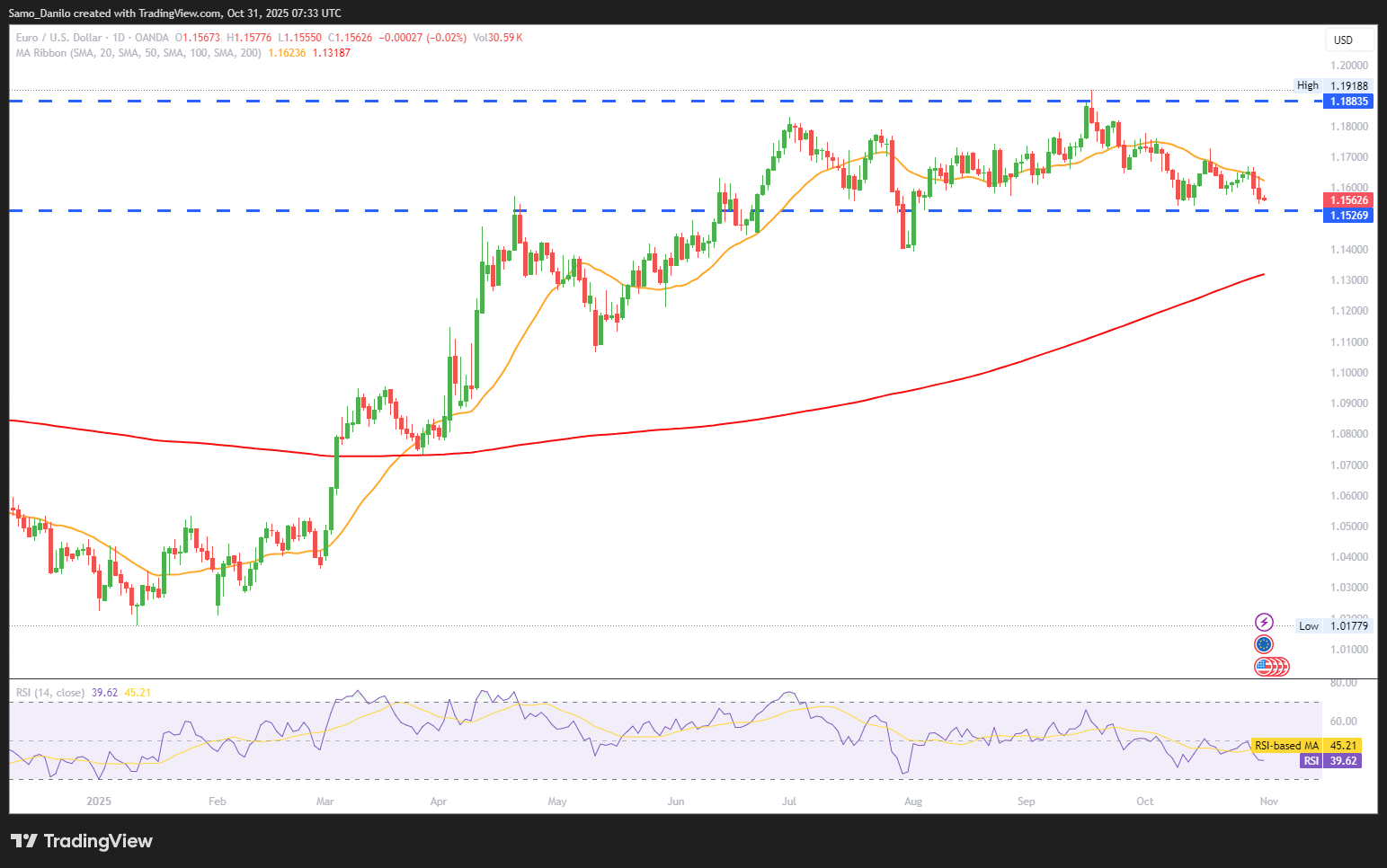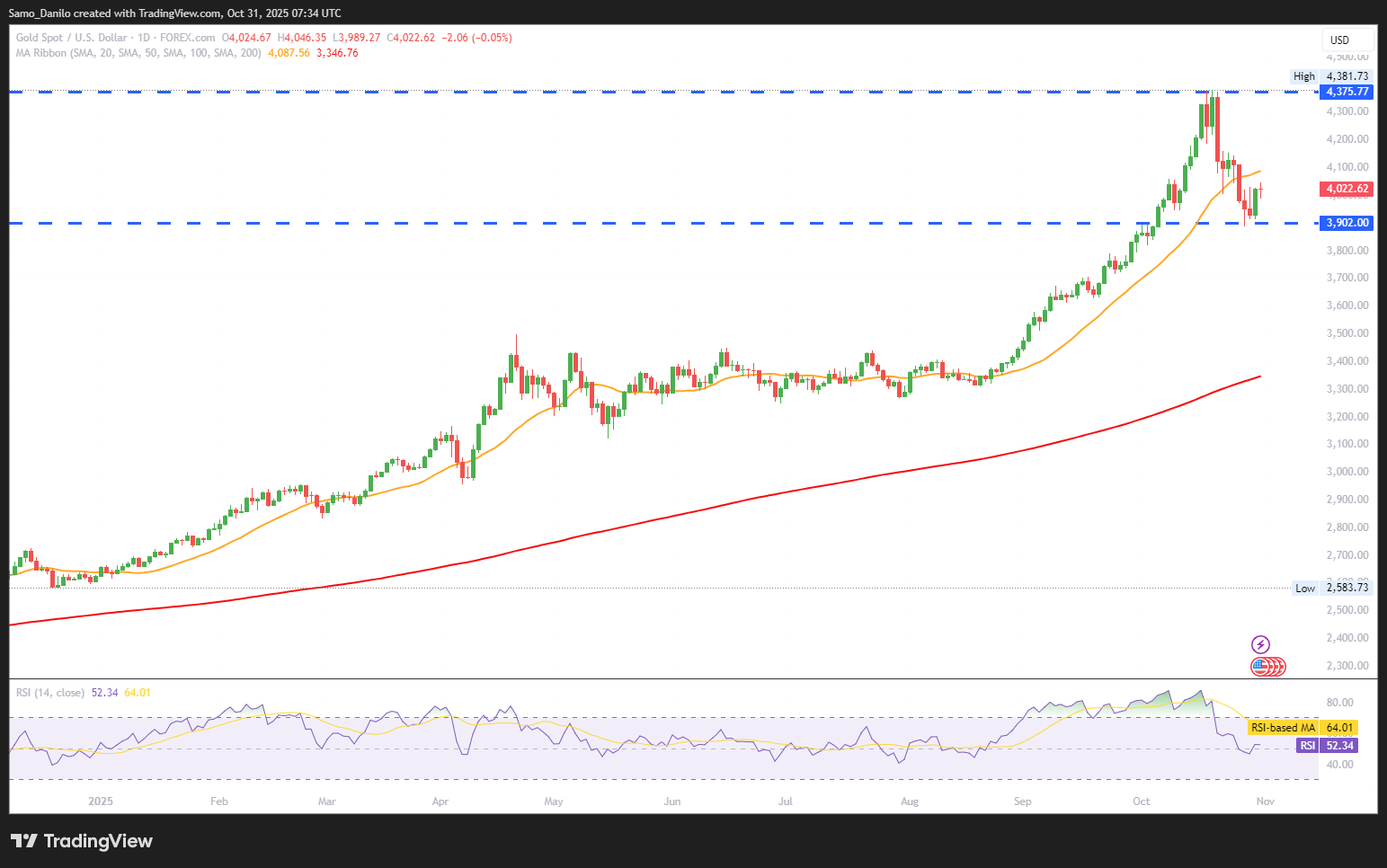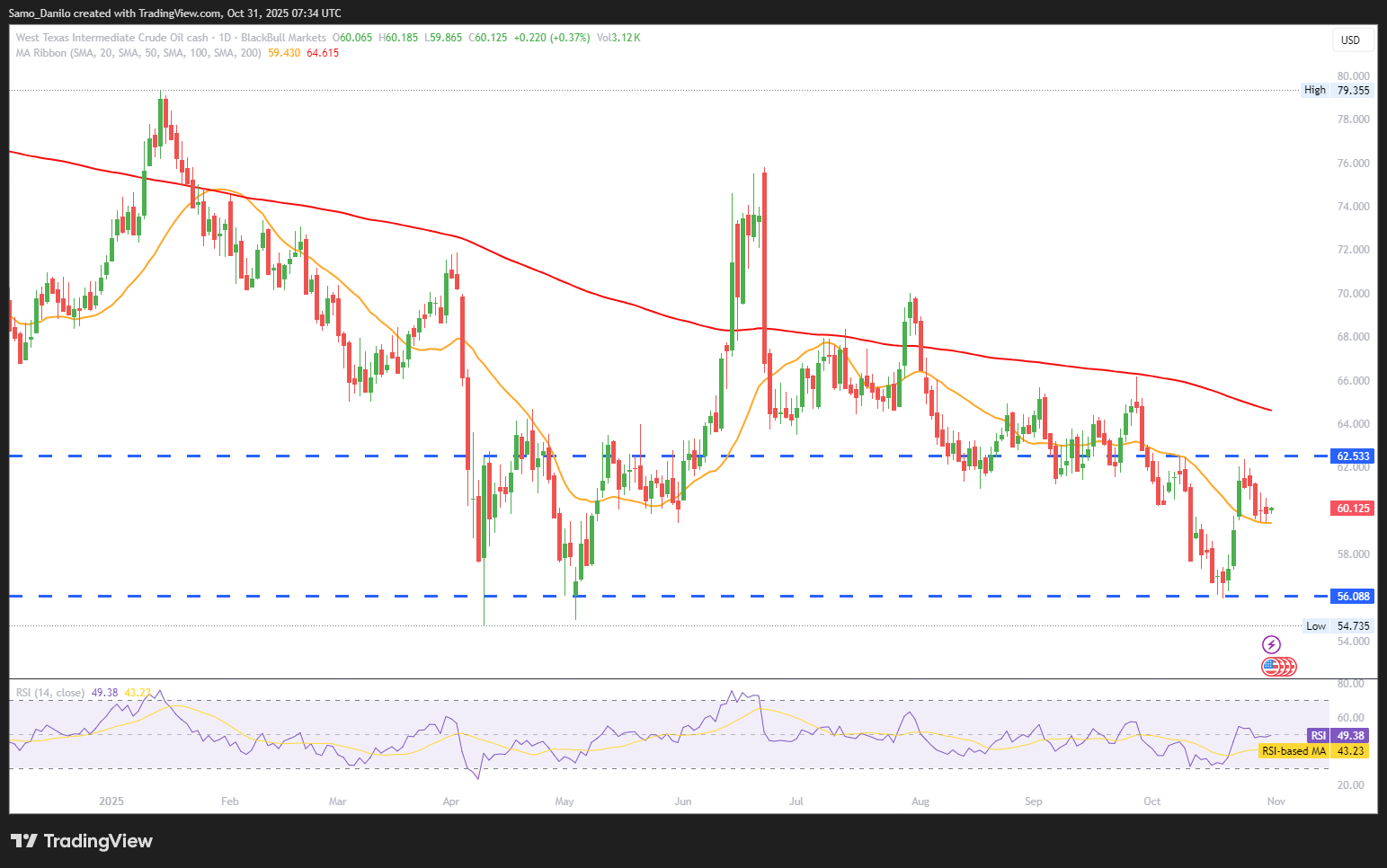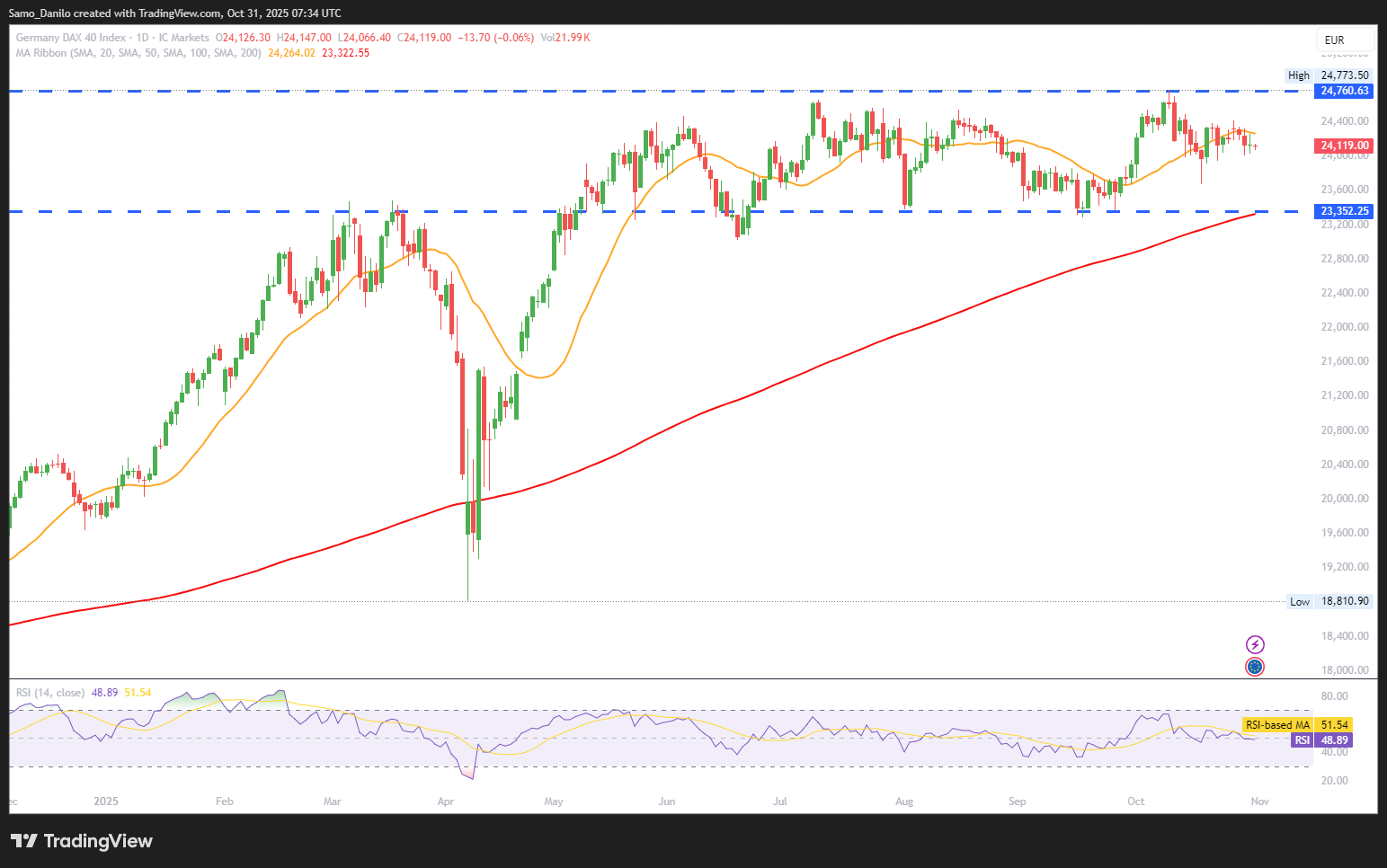EURUSD
- EUR/USD Price: The EUR/USD pair trades cautiously around 1.1555 in early European hours on Friday, extending its consolidation near recent lows. A stronger U.S. Dollar and lack of fresh catalysts from the ECB keep the Euro under mild pressure ahead of key inflation data.
- ECB Rates: The European Central Bank (ECB) left its Deposit Facility rate unchanged at 2%, citing inflationary pressures that remain broadly in line with the 2% target. The statement provided no clear forward guidance, signaling policymakers prefer to assess incoming data before adjusting policy further.
- ECB's Kocher: ECB Governing Council member Martin Kocher noted that projections show inflation “on target for sustained time,” reinforcing the view that no immediate rate action is necessary. His comments highlight the ECB’s confidence in maintaining price stability without over-tightening.
- Deutsche Bank: According to Deutsche Bank’s chief European economist, the ECB’s decision underscores the Eurozone’s relative economic resilience, despite global uncertainties. The stance keeps dovish voices contained, supporting a steady policy path through year-end.
- HICP Data: Traders are turning their attention to the preliminary Eurozone Harmonized Index of Consumer Prices (HICP) for October, due at 10:00 GMT. A stronger-than-expected reading could provide short-term support for the Euro, while softer data might push EUR/USD toward fresh lows.
Closing statement: The EUR/USD pair remains on the defensive near 1.1555, weighed by a steady ECB stance and resilient USD demand. Market direction now hinges on Eurozone inflation data, which could determine whether the pair stabilizes above 1.15 or resumes its downward trajectory into next week.
GBPUSD
- GBP/USD Price: The GBP/USD pair trades near 1.3130 in early European trading on Friday, extending its decline for a fourth consecutive day. The stronger U.S. Dollar continues to weigh on the pair as risk sentiment weakens ahead of key U.S. data.
- Powell’s Comments: The Greenback strengthened after Fed Chair Jerome Powell said the central bank faces challenges balancing inflation control and employment support due to limited data availability during the U.S. government shutdown. His remarks revived expectations of a prolonged restrictive stance, pressuring the Pound.
- BoE Rate Cut: The Pound Sterling remains under pressure as expectations for Bank of England (BoE) rate cuts build. The latest BRC inflation report showed a continued decline in food price growth, reinforcing the case for easing monetary policy in early 2026.
- Fiscal Uncertainty: UK Prime Minister Keir Starmer’s refusal to rule out tax hikes during Wednesday’s parliamentary session has fueled investor caution. Possible increases in income tax, national insurance, or VAT could dampen consumer sentiment and weigh on near-term economic growth.
- OBR Outlook: Reports suggest the Office for Budget Responsibility (OBR) will downgrade the UK’s productivity growth forecast by 0.3%, potentially creating a £20 billion shortfall in public finances. This revision underscores the structural challenges facing the UK economy.
Closing statement: The GBP/USD pair remains pressured around 1.3130, with hawkish Fed rhetoric and rising BoE rate-cut bets keeping Sterling on the defensive. Unless incoming UK data or fiscal signals turn more supportive, the pair could test the 1.3080 support zone before attempting any meaningful rebound.
XAUUSD
- XAU/USD Price: XAU/USD hovers just above $4015 during the European session on Friday, struggling to sustain early gains amid a mixed fundamental backdrop. The metal remains rangebound as investors weigh shifting Fed expectations against ongoing U.S. political tensions.
- Fed Rate: Market optimism for further Fed policy easing cooled after Chair Jerome Powell downplayed prospects of another December rate cut, following Wednesday’s 25 bps reduction to the 3.75%-4.00% range. His remarks suggested that additional cuts are not guaranteed, limiting gold’s upside momentum.
- Rate Futures: Despite Powell’s caution, the CME FedWatch Tool shows traders now pricing in a 71% probability of another rate cut in December, up from 66% a day earlier. This lingering dovish bias continues to offer some support to non-yielding assets like gold.
- Trade Breakthrough: The Trump–Xi meeting concluded positively, with the U.S. agreeing to lower tariffs in exchange for China resuming soybean imports and maintaining rare earth exports. The deal boosted risk appetite, reducing short-term safe-haven demand for gold.
- Government Shutdown: The fifth week of the U.S. government shutdown continues to heighten economic uncertainty, partly offsetting the effects of improved trade sentiment. The prolonged deadlock in Congress keeps gold supported as investors hedge against potential fiscal disruptions.
Closing statement: Gold remains rangebound near $4015, caught between reduced Fed cut expectations and persistent U.S. fiscal risks. Unless political uncertainty deepens or U.S. data weakens, XAU/USD may consolidate within the $3980–$4050 range in the near term, with limited directional conviction.
CRUDE OIL
- Crude Oil Price: West Texas Intermediate (WTI) crude advances early Friday in Europe, trading near $60.15 per barrel. The rise follows a modest rebound in risk sentiment, although geopolitical tensions and weak Chinese data continue to cloud the demand outlook.
- Nuclear Tensions: Oil prices reacted cautiously after President Trump ordered the resumption of US nuclear testing, prompting Russia to threaten reciprocal action. The news sparked fears of renewed global instability, adding a layer of geopolitical risk premium to crude markets.
- US Data: With the US government still closed, traders face a data vacuum, redirecting attention toward Federal Reserve commentary for signals on the next policy move. Any dovish tone could support risk assets, indirectly benefiting oil demand expectations.
- China PMI: The Chinese manufacturing PMI slipped to 49.0 in October, staying below the 50-point contraction threshold. The decline underscores fragile industrial demand and waning pre-holiday activity, reinforcing concerns about sluggish energy consumption in the world’s largest crude importer.
- Kazakhstan Oil: The Kazakh government has resumed negotiations with ExxonMobil over expanding the Kashagan oil field, one of the largest global developments. Discussions may include new western reservoir sections and linkages to Exxon’s Tengiz project, signaling potential long-term supply growth.
Closing statement: WTI holds above $60, supported by heightened geopolitical risk and speculative buying, but demand-side weakness from China tempers momentum. In the near term, crude may fluctuate within the $59.50–$60.80 range, awaiting Fed commentary and further geopolitical clarity for directional cues.
DAX
- DAX Price: The German DAX continues to trade in a narrow consolidation range near 24,125 points, maintaining this week’s sideways trajectory. Market participants appear cautious, awaiting stronger catalysts from European macro data and upcoming corporate earnings.
- German Inflation: October CPI rose 2.3% y/y, marginally above the 2.2% consensus but down from 2.4% in September. The data indicates persistent price pressures, though the gradual deceleration reinforces expectations that inflation is stabilizing near the ECB’s target.
- Eurozone GDP: Euro area GDP expanded by 0.2% q/q in Q3, doubling the previous quarter’s growth rate and beating forecasts. The result highlights modest but improving economic resilience, supporting a neutral-to-positive backdrop for European equities.
- Regional Inflation: Following upside surprises in Germany and Spain, traders now await Eurozone flash inflation data for October. Any broad confirmation of rising price pressures could influence ECB policy expectations, potentially restraining equity upside if rate-cut hopes fade.
- ECB's Lagarde: ECB President Christine Lagarde stated that downside growth risks have diminished, referencing progress in US-EU trade talks and better US-China relations. Her comments may bolster investor confidence, supporting a steady tone in European markets.
Closing statement: The DAX remains range-bound around 24,000–24,200, reflecting investor caution amid mixed inflation signals and modest economic growth. With improving trade dynamics and stabilizing prices, the index could edge higher short term, though sustained momentum likely depends on Eurozone inflation results and ECB policy signals.




